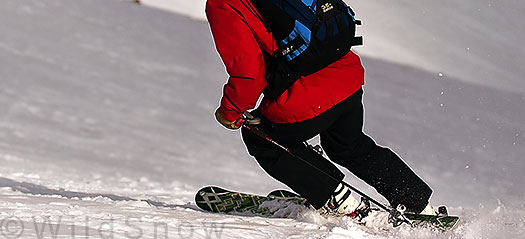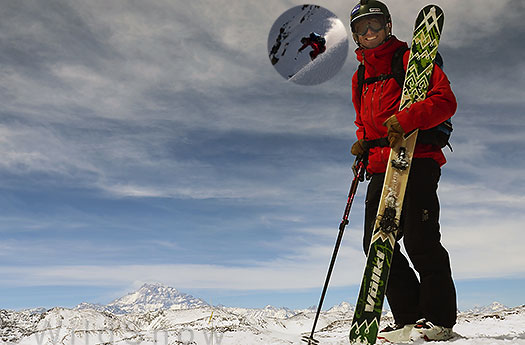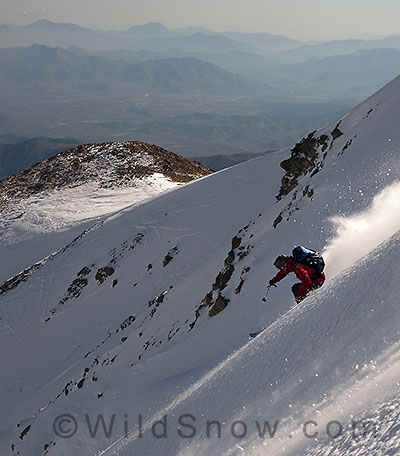Anton Sponar

Anton riding the Nunataq in South America.
Having skied extensively in the Andes Mountains for the last five years, I frequently get asked what it is like to ski there. My answer is a simple word: Different. No two days are the same. You could go up the day after a storm and have the best blower powder day of your life. That night the wind will pick up, and you will ski the most heinous crust or sastrugi imaginable. For this reason the Andes are a superb place to see what a ski (and a skier) are really made of. This year’s backcountry skiing victim: Volkl Nunataq.
First the specs:
Dimensions: 139-107-123
Radius: 27.4 m
Length tested: 178 cm
Weight per ski: 63 oz, 1786 gr (see WildSnow real world ski weights)
Style: Full Rocker (slight, see photo)
Binding: Dynafit FT 12
Skier: Ex downhill racer turned dirt bag ski guide at Ski Arpa Cat Skiing. 160 lbs (soaking wet). I like to go fast.

Anton in Chile, Volkl Nunataq review 2011 2012. Is this the WildSnow SA headquarters? Stay tuned.
I skied the Nunataq nearly every day this Austral season — on nearly every type of snow imaginable. My report follows.

Volkl Nunataq rocker
Powder (I know there are many different types of powder, but this is a ski review not an avi course):
It is my opinion that just about anything will ski well in powder. However, Nunataq were made for the fluff. It truly was a dream to have planks these on my feet after some of our big Andean dumps. Effortless is a good description, playful being another (but rather overused these days in ski reviews). I felt as though I could do anything on the Nunataq. At speed (and I mean SPEED) I could throw the skis sideways and begin a McConkey turn (basically a high speed pivot) that would last a couple hundred vertical. This would result in a 3-7 second face shot than can only be comparable to a surfer getting that extra long barrel ride. I was getting it every turn all day though. It was almost not fair. Almost. I have skied quite a few powder specific skis in my day, but the Nunataq is my favorite.
So, the pow day is over. Now what?
Crust (Cartton en Espanol):
The hair on the back of my neck stands on end when I hear this word. I have visceral memories of coming into sections of cartton that resulted in violent cart wheeling. Not fun stuff in any mountain range. The Andes seem to get crust that will destroy a skier’s soul. The Nunataqs can now also be called Soul Savers. Skiing the cartton was by no means easy on them, but my day was not ruined because of the crust. The full rocker helped to deflect the tip of the ski up on top of the hard layer of snow on the surface and break through it. In fact, I could ski it well enough to make my clients think that the snow was going to be good. This did not always end well for them, or any tips that may have been heading my way, but at least I was having a good time.
Hardpack (aka wind board or the natural groomer):
After long periods of wind and no new snow we start to develop what we affectionately call wind board. This is a hard surface layer of snow that the wind makes nice and smooth. I describe it to my clients as Triple F: firm, fast and fun. Initially this was what I imagined would be the weakness for the fully rockered Nunatag. However, I was pleasantly surprised. They by no means performed like a race ski on the hard stuff, but I didn’t expect them to. I didn’t get the usual bone rattling, totally unresponsive feel that I usually get with a fully rockered ski while trying to coax them down a smooth hard surface. In fact, I found that I could actually arc some turns. Wild!
Corn (Nieve choclo, literal translation that makes no sense to any Spanish speaker):
Much like in powder the Nunatag gave me a goofy smile that made it look like I had just gotten away with something that I shouldn’t have. My mother would be very worried about what I have been up to after seeing me ski these in the warm, soft snow of the spring.
Sustrugi (Hard snow formations created by wind that look like mini UFOs):
Nothing skis well on Sustrugi. Nothing. Snowcats drive over it okay — so long as it’s less than two feet high.
Rocks (not snow):
See durability.
That does it for the types of snow, now on to other aspects of a ski that I find to be important.
Touring:
If you prefer, you can purchase your Nunataq with a set of pre-cut nylon/mohair skins in a lovely shade of blue (cost additional). The tip attachment is a hole in the tip of the ski that a peg on the front of the skin goes into (same as the excellent K2 skin system that Lou tested and passed on Denali). It attaches to the tail with a clip. Once the skins are on they are super secure. Or, if you prefer for backcountry skiing, the conventional tip and tail of the Nunataq also work with nearly any other type of skin attachment. The slight but long rocker of the Nunataq makes touring through new snow very easy. Submarining the tip is easily avoided, hence less energy is expelled. The light weight of the ski also makes for an enjoyable tour to the top of your favorite powder stash.
All Around Backcounty Use:
Volkl Nunatag is made for the backcountry. The holes for the tip attachment can be used to make a makeshift backcountry rescue sled in case of an emergency. The tip holes also enhance the face shots! Bonus! The tails are flat so that anchors can be easily made. The flat tail also makes it easy to plunge the ski into the ground on those steep transitions. Again, the remarkably light weight vs width of this bigger ski has is another obvious benefit to backcountry human-powered use.

Volkl Nunataq graphics, most folks like.
Durability:
In my opinion this is the one drawback to the Nunatag (though any ski made lightweight for human powered uphill may need to compromise in this area). The bases are quite thin. Indeed this contributes to weight reduction, but having every rock hit become a core shot gets old. (Disclaimer: I used the Volkl Nunataqs in the Andes. The rocks there are sharp and everywhere. I am also a person who views their skis as tools, not jewels. I ask a lot from the durability of my ski.) The other issue that I could see arising is that of the construction of the ski. It has a wood core, but has what I can only describe as air pockets. This is huge as far as keeping the weight down, and as far as I could tell did not impact how it performs. It does make me think that the life of the ski and its durability may be suspect. This is only my assumption though. I had no issues with it over the three months that I used them.

Anton on Nunataq, Ski Arpa, Sud America.
Overall Impression:
Volkl Nunataq is a backcountry skiing powder machine, and it should be used as so. If you are looking to add a light weight rockered pow ski to your quiver, that could also be used as an everyday ski if need be, look no farther. I also got quite a few positive remarks on the aesthetics of the ski. This may help me with all the ladies in the backcountry, or something? This is the ski that I will use to get to all my powder stashes in the Elks all winter. I am starting to shake with excitement just thinking of the fun I will have doing that.
(Guest blogger Anton Sponar spends winters enjoying the skiing ambiance of the Aspen area, while summers are taken up with slave labor doing snowcat powder guiding at Ski Arpa in Chile. If Anton didn’t ski every month of the year, skiing would cease to exist as we know it. He sometimes spells Nunataq as Nunatag.)
Beyond our regular guest bloggers who have their own profiles, some of our one-timers end up being categorized under this generic profile. Once they do a few posts, we build a category. In any case, we sure appreciate ALL the WildSnow guest bloggers!
